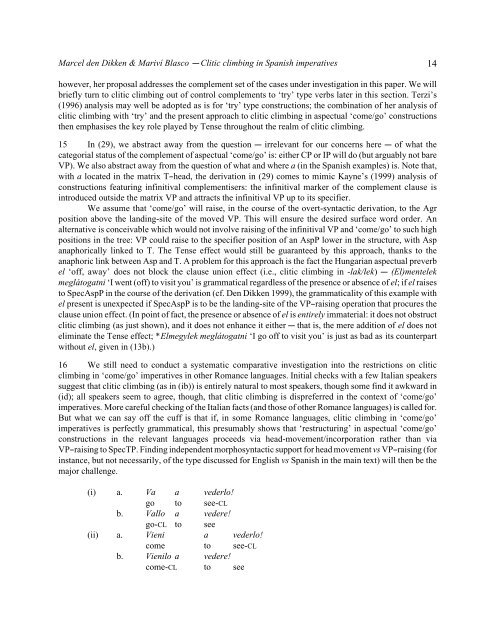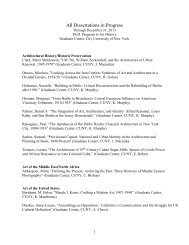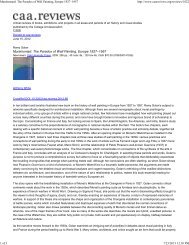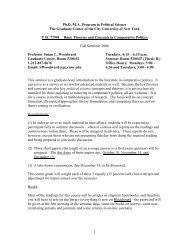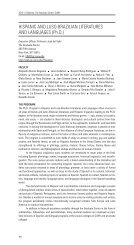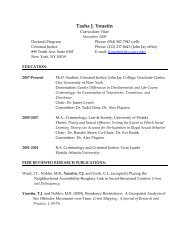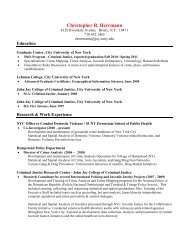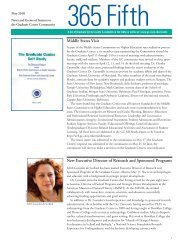Clitic climbing in Spanish imperatives - CUNY Graduate Center
Clitic climbing in Spanish imperatives - CUNY Graduate Center
Clitic climbing in Spanish imperatives - CUNY Graduate Center
You also want an ePaper? Increase the reach of your titles
YUMPU automatically turns print PDFs into web optimized ePapers that Google loves.
Marcel den Dikken & Mariví Blasco & <strong>Clitic</strong> <strong>climb<strong>in</strong>g</strong> <strong>in</strong> <strong>Spanish</strong> <strong>imperatives</strong><br />
however, her proposal addresses the complement set of the cases under <strong>in</strong>vestigation <strong>in</strong> this paper. We will<br />
briefly turn to clitic <strong>climb<strong>in</strong>g</strong> out of control complements to ‘try’ type verbs later <strong>in</strong> this section. Terzi’s<br />
(1996) analysis may well be adopted as is for ‘try’ type constructions; the comb<strong>in</strong>ation of her analysis of<br />
clitic <strong>climb<strong>in</strong>g</strong> with ‘try’ and the present approach to clitic <strong>climb<strong>in</strong>g</strong> <strong>in</strong> aspectual ‘come/go’ constructions<br />
then emphasises the key role played by Tense throughout the realm of clitic <strong>climb<strong>in</strong>g</strong>.<br />
15 In (29), we abstract away from the question & irrelevant for our concerns here & of what the<br />
categorial status of the complement of aspectual ‘come/go’ is: either CP or IP will do (but arguably not bare<br />
VP). We also abstract away from the question of what and where a (<strong>in</strong> the <strong>Spanish</strong> examples) is. Note that,<br />
with a located <strong>in</strong> the matrix T%head, the derivation <strong>in</strong> (29) comes to mimic Kayne’s (1999) analysis of<br />
constructions featur<strong>in</strong>g <strong>in</strong>f<strong>in</strong>itival complementisers: the <strong>in</strong>f<strong>in</strong>itival marker of the complement clause is<br />
<strong>in</strong>troduced outside the matrix VP and attracts the <strong>in</strong>f<strong>in</strong>itival VP up to its specifier.<br />
We assume that ‘come/go’ will raise, <strong>in</strong> the course of the overt-syntactic derivation, to the Agr<br />
position above the land<strong>in</strong>g-site of the moved VP. This will ensure the desired surface word order. An<br />
alternative is conceivable which would not <strong>in</strong>volve rais<strong>in</strong>g of the <strong>in</strong>f<strong>in</strong>itival VP and ‘come/go’ to such high<br />
positions <strong>in</strong> the tree: VP could raise to the specifier position of an AspP lower <strong>in</strong> the structure, with Asp<br />
anaphorically l<strong>in</strong>ked to T. The Tense effect would still be guaranteed by this approach, thanks to the<br />
anaphoric l<strong>in</strong>k between Asp and T. A problem for this approach is the fact the Hungarian aspectual preverb<br />
el ‘off, away’ does not block the clause union effect (i.e., clitic <strong>climb<strong>in</strong>g</strong> <strong>in</strong> -lak/lek) & (El)mentelek<br />
meglátogatni ‘I went (off) to visit you’ is grammatical regardless of the presence or absence of el; if el raises<br />
to SpecAspP <strong>in</strong> the course of the derivation (cf. Den Dikken 1999), the grammaticality of this example with<br />
el present is unexpected if SpecAspP is to be the land<strong>in</strong>g-site of the VP%rais<strong>in</strong>g operation that procures the<br />
clause union effect. (In po<strong>in</strong>t of fact, the presence or absence of el is entirely immaterial: it does not obstruct<br />
clitic <strong>climb<strong>in</strong>g</strong> (as just shown), and it does not enhance it either & that is, the mere addition of el does not<br />
elim<strong>in</strong>ate the Tense effect; *Elmegylek meglátogatni ‘I go off to visit you’ is just as bad as its counterpart<br />
without el, given <strong>in</strong> (13b).)<br />
16 We still need to conduct a systematic comparative <strong>in</strong>vestigation <strong>in</strong>to the restrictions on clitic<br />
<strong>climb<strong>in</strong>g</strong> <strong>in</strong> ‘come/go’ <strong>imperatives</strong> <strong>in</strong> other Romance languages. Initial checks with a few Italian speakers<br />
suggest that clitic <strong>climb<strong>in</strong>g</strong> (as <strong>in</strong> (ib)) is entirely natural to most speakers, though some f<strong>in</strong>d it awkward <strong>in</strong><br />
(id); all speakers seem to agree, though, that clitic <strong>climb<strong>in</strong>g</strong> is dispreferred <strong>in</strong> the context of ‘come/go’<br />
<strong>imperatives</strong>. More careful check<strong>in</strong>g of the Italian facts (and those of other Romance languages) is called for.<br />
But what we can say off the cuff is that if, <strong>in</strong> some Romance languages, clitic <strong>climb<strong>in</strong>g</strong> <strong>in</strong> ‘come/go’<br />
<strong>imperatives</strong> is perfectly grammatical, this presumably shows that ‘restructur<strong>in</strong>g’ <strong>in</strong> aspectual ‘come/go’<br />
constructions <strong>in</strong> the relevant languages proceeds via head-movement/<strong>in</strong>corporation rather than via<br />
VP%rais<strong>in</strong>g to SpecTP. F<strong>in</strong>d<strong>in</strong>g <strong>in</strong>dependent morphosyntactic support for head movement vs VP%rais<strong>in</strong>g (for<br />
<strong>in</strong>stance, but not necessarily, of the type discussed for English vs <strong>Spanish</strong> <strong>in</strong> the ma<strong>in</strong> text) will then be the<br />
major challenge.<br />
(i) a. Va a vederlo!<br />
go to see-CL<br />
b. Vallo a vedere!<br />
go-CL to see<br />
(ii) a. Vieni a vederlo!<br />
come to see-CL<br />
b. Vienilo a vedere!<br />
come-CL to see<br />
14


